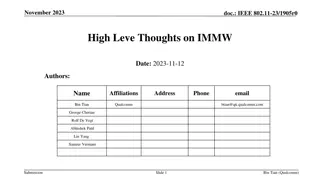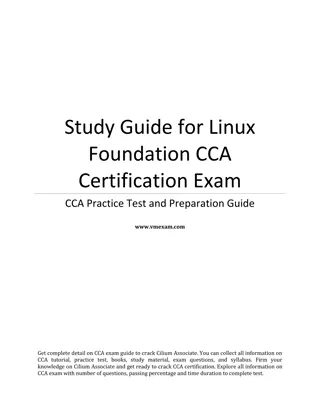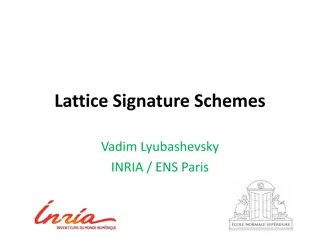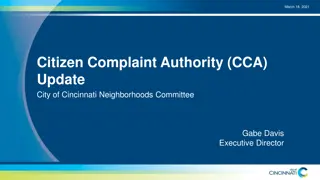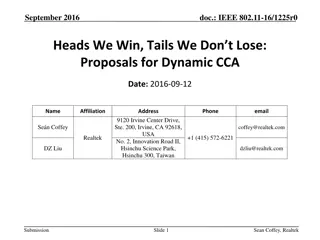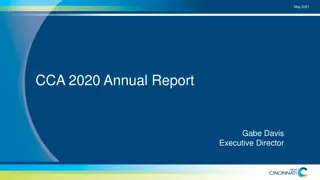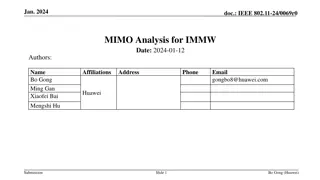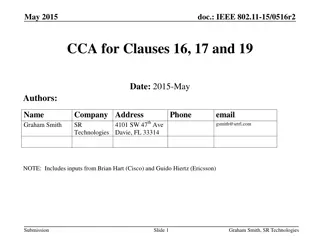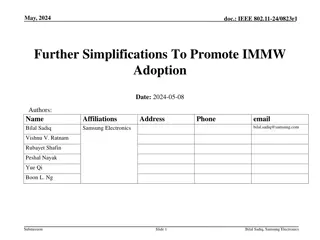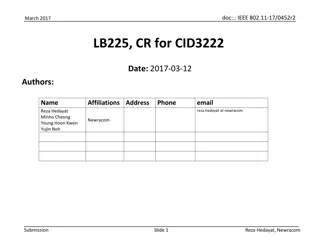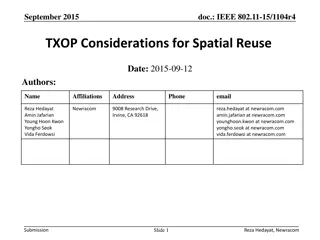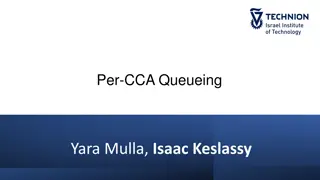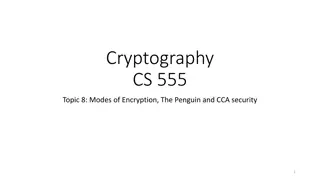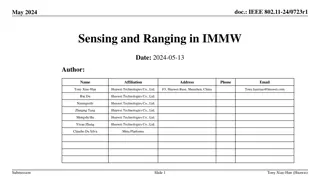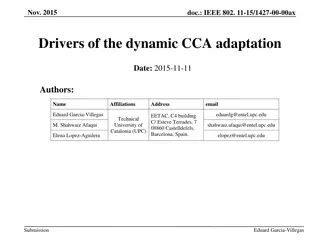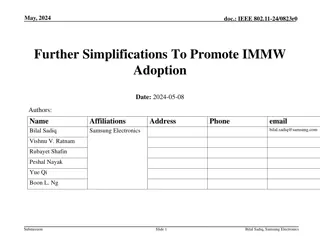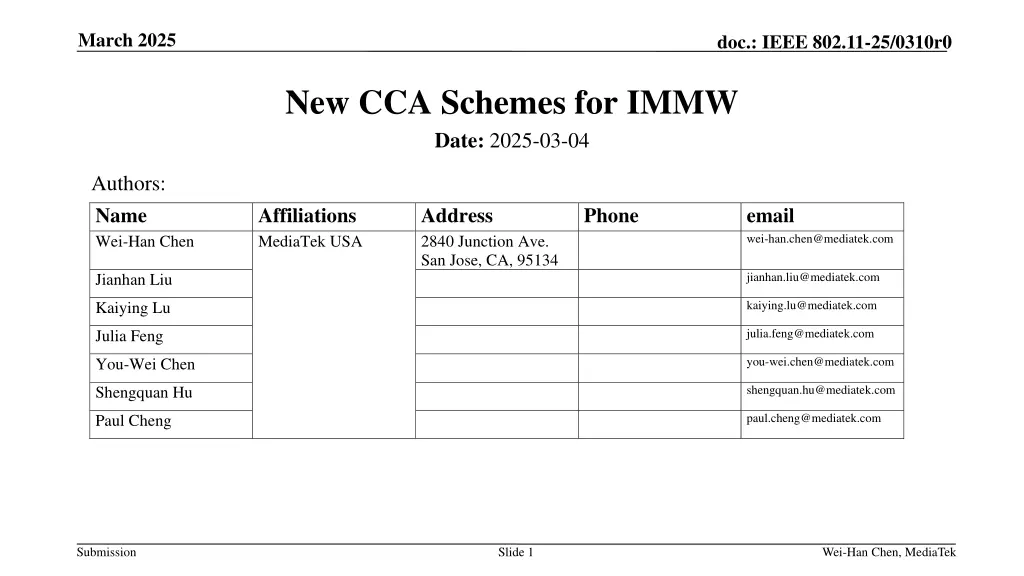
New CCA Schemes for IMMW Enhancing WiFi Communication
Explore the innovative IEEE 802.11-25/0310r0 document proposing new Clear Channel Assessment (CCA) schemes to address communication challenges in the mmWave bands for IMMW technology. The document introduces calibrated antenna patterns and efficient CCA procedures to optimize channel access and transmission reliability in WiFi networks, enhancing overall performance and connectivity.
Download Presentation

Please find below an Image/Link to download the presentation.
The content on the website is provided AS IS for your information and personal use only. It may not be sold, licensed, or shared on other websites without obtaining consent from the author. If you encounter any issues during the download, it is possible that the publisher has removed the file from their server.
You are allowed to download the files provided on this website for personal or commercial use, subject to the condition that they are used lawfully. All files are the property of their respective owners.
The content on the website is provided AS IS for your information and personal use only. It may not be sold, licensed, or shared on other websites without obtaining consent from the author.
E N D
Presentation Transcript
March 2025 doc.: IEEE 802.11-25/0310r0 New CCA Schemes for IMMW Date: 2025-03-04 Authors: Name Wei-Han Chen Affiliations MediaTek USA Address 2840 Junction Ave. San Jose, CA, 95134 Phone email wei-han.chen@mediatek.com jianhan.liu@mediatek.com Jianhan Liu kaiying.lu@mediatek.com Kaiying Lu julia.feng@mediatek.com Julia Feng you-wei.chen@mediatek.com You-Wei Chen shengquan.hu@mediatek.com Shengquan Hu paul.cheng@mediatek.com Paul Cheng Submission Slide 1 Wei-Han Chen, MediaTek
March 2025 doc.: IEEE 802.11-25/0310r0 Introduction IMMW expands the Multi-link Operation (MLO) defined in the sub-7 GHz band specifications to support non-standalone operation in the mmWave bands (between 42 GHz and 71 GHz). We consider that each mmWave STA (mSTA) can be paired with one other mSTA through the IMMW AP in the sub-7 GHz band. can request pairing with another mSTA if it wishes to communicate with it. Submission Slide 2 Wei-Han Chen, MediaTek
March 2025 doc.: IEEE 802.11-25/0310r0 Problem Statement Paired mSTAs can communicate with each other using directional antenna patterns in the mmWave band. However, two problems arise regarding CCA. Omni-directional single antenna CCA might not provide enough link budget. CCA may need to be conducted using directional antenna array. The antenna pattern (RX) for CCA does not necessarily align with the antenna pattern for transmission (TX). This misalignment can result in delayed transmissions or interference with other mSTAs. An mSTA may detect different transmissions, each with its own NAV duration, from various directions while performing CCA. Determining how to update the NAV timer(s) when multiple transmissions are detected is a complex and implementation dependent problem. To address these problems, we propose new CCA schemes for IMMW. Slide 3 Submission Wei-Han Chen, MediaTek
March 2025 doc.: IEEE 802.11-25/0310r0 Proposed Scheme 1 Each mSTA s antenna patterns are calibrated, meaning that the receive antenna pattern (for CCA) aligns with the transmit antenna pattern (for transmission). For example, one can use different Antenna Weight Vectors (AWV) for transmitting and receiving. By adjusting these AWVs, the transmit antenna pattern can be made to closely align with the receive antenna pattern. For scheme 1, we propose that an mSTA performs CCA check only for the direction it wishes to transmit. maintains a single NAV timer and backoff counter. If multiple transmissions are detected, update the NAV to the longest duration. follows Enhanced Distributed Channel Access (EDCA) rules for channel access. when allowed to transmit, transmits in the direction in which it performs CCA. Submission Slide 4 Wei-Han Chen, MediaTek
March 2025 doc.: IEEE 802.11-25/0310r0 Proposed Scheme 1 Illustrating scheme 1 with an example. mSTA1 is paired with mSTA3. Before transmitting to mSTA3, mSTA1 performs CCA only in direction 2 (assuming mSTA1 uses four antenna patterns to cover CCA direction 1 through 4). Meanwhile, mSTA5 starts transmitting to mSTA4. mSTA1 detects mSTA5 s transmission and updates its NAV accordingly. Once the NAV clears, mSTA1 performs CCA in direction 2 and follows EDCA rules to transmit to mSTA3. Since mSTA1 s antenna patterns are calibrated, it can perform CCA and transmit in the same direction, i.e., direction 2 in this case. CCA direction 1 mSTA5 mSTA4 CCA direction 2 CCA direction 4 mSTA1 mSTA2 mSTA3 CCA direction 3 Submission Slide 5 Wei-Han Chen, MediaTek
March 2025 doc.: IEEE 802.11-25/0310r0 Proposed Scheme 2 The mSTA s antenna patterns are not calibrated, meaning that the receive antenna pattern (for CCA ) does not necessarily align with the transmit antenna pattern (for transmission). For Scheme 2, we propose that an mSTA scans all directions for CCA check using directional antenna patterns. maintains a single NAV timer and backoff counter. If multiple transmissions are detected, update the NAV to the longest duration among them. follows EDCA rules for channel access. suspends backoff if CCA is busy during the scanning or NAV is set. transmits when the NAV clears and the backoff counter reaches zero. Submission Slide 6 Wei-Han Chen, MediaTek
March 2025 doc.: IEEE 802.11-25/0310r0 Proposed Scheme 2 Illustrating scheme 2 with an example. All mSTAs are within the same BSS. mSTA1 is paired with mSTA2. Before transmitting to mSTA2, mSTA1 uses four wide antenna patterns to scan the surroundings for CCA. Meanwhile, mSTA4 is transmitting to mSTA3, and mSTA5 is transmitting to mSTA6. mSTA1 detects these two transmissions during CCA scanning and sets its NAV to the longest duration among them. Once the NAV clears, mSTA1 performs CCA in all four directions. If CCA indicates a busy channel in any direction, mSTA1 suspends the backoff. Following EDCA rules, mSTA1 can transmit to mSTA2 when the NAV timer clears and the backoff counter reaches zero. CCA direction 1 CCA direction 2 CCA direction 4 mSTA1 mSTA2 mSTA5 mSTA6 mSTA4 mSTA3 CCA direction 3 Submission Slide 7 Wei-Han Chen, MediaTek
March 2025 doc.: IEEE 802.11-25/0310r0 Proposed Scheme 3 The mSTA s antenna patterns are not calibrated. For Scheme 3, we propose that an mSTA performs CCA check using omni- directional single antenna. The CCA threshold should be adjusted due to lack of directional gain from single antenna. maintains a single NAV timer and backoff counter. If multiple transmissions are detected, update the NAV to the longest duration among them. follows EDCA rules for channel access. suspends backoff if CCA is busy during the scanning or NAV is set. transmits when the NAV clears and the backoff counter reaches zero. Submission Slide 8 Wei-Han Chen, MediaTek
March 2025 doc.: IEEE 802.11-25/0310r0 Summary We proposed new CCA schemes for IMMW. Scheme 1: For a calibrated mSTA, it can perform directional CCA. Scheme 2: For an uncalibrated mSTA, it uses directional antenna patterns to scan all directions for CCA. Scheme 3: For an uncalibrated mSTA, it uses omni-directional single antenna for CCA. Submission Slide 9 Wei-Han Chen, MediaTek
March 2025 doc.: IEEE 802.11-25/0310r0 Straw Poll 1 Do you agree that IMMW allows a calibrated mSTA to perform CCA only in the direction it wishes to transmit? Submission Slide 10 Wei-Han Chen, MediaTek
March 2025 doc.: IEEE 802.11-25/0310r0 Straw Poll 2 Do you agree that IMMW requires an uncalibrated mSTA, if using directional antenna patterns, to scan all directions for CCA? Submission Slide 11 Wei-Han Chen, MediaTek
March 2025 doc.: IEEE 802.11-25/0310r0 Straw Poll 3 Do you agree that when an IMMW mSTA uses an omni-directional single antenna for CCA, the CCA threshold should be adjusted? Submission Slide 12 Wei-Han Chen, MediaTek
March 2025 doc.: IEEE 802.11-25/0310r0 References Submission Slide 13 Wei-Han Chen, MediaTek

